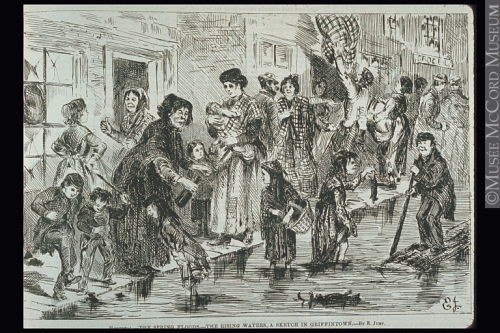With industrial growth along the canal, Griffintown became a working class ghetto of mainly Irish immigrants. The booming industrialization of Montreal provided both skilled and unskilled work for these immigrants, most of whom settled in areas around the basins- Point St. Charles, Goose Bay and Griffintown. As the community grew, a church was built to accommodate the needs of the largely Irish Catholic community. St. Ann’s Church and the monastics who administered the school would become integral to the ebb and flow of the community until the church’s destruction in 1970.

House in Griffintown on corner of Barre and Aquaduct streets, 1903, courtesy of McCord Museum collection, Wm. Notman & Son
While Irish immigration had been occurring during the early nineteenth century, famine and economic depression in Ireland in 1845-52 propelled immigration from the island, often in squalid coffin ships. (Thorton and Olson: Tidal Wave, 2) Large construction projects such as the Lachine Canal (finished in 1825) Grand Trunk Railroad depot in 1853 by Point St. Charles, and the Victoria Bridge in 1859 provided work in the region. In addition to these projects, heavy industry such as machinery and metalwork, furniture manufacturing, and textiles employed over 4,000 men, women and children within the area-though, as with most heavy industry, the workforce was primarily men and children.(Solonysznyj: Residential Persistence, 5)

The Grand Trunk Railway head office remains in tact on rue McGill college. The railroad was the area's largest industrial employer. Photo by Aymeric Grail, 2009
Montreal was experiencing an industrial expansion. The railroad boom in the United States provided a market for metallurgy, and the canal allowed Montreal to grow as a port city, replacing Halifax and Port Hawkesbury as the gateway to Canada from the Atlantic. The Grand Trunk Railroad depot employed 750 workers(Ibid., 6), many of whom were better paid than other perceivably unskilled workers within Montreal. The bulk of employment in the area remained in unskilled factory positions.
The economic contraction of 1873 resonated throughout working-class Montreal. As protectionary tactics closed American and British borders to Canadian goods, the unresolved Canadian tariff system left Canadian markets flooded with foreign goods. Prices fell, and many firms that had opened during the economic boom were forced to declare bankruptcy. John A. MacDonald’s National Plan remedied some of the industrial decline, though the fate of industrial capitalism remained precarious. Job insecurity and loss of employer confidence plagued the area since the depression, ” the permanent sense of insecurity was a part of everyday life for the people of St Anne’s.” (Sobolewsky: Residential Persistence, 36).
Tragedy hit twice in the region. The first came as a city-wide smallpox epidemic in 1885 that ravaged the working class neighborhoods, whose geographic circumstances and lack of public works facilitated the spread of the disease. The disease claimed 3,000. (Ibid., 8 ) One year later, the protective barriers along the St Lawrence river gave way to the rising waters. Low-lying regions of Montreal, including Griffintown and the Grand Trunk Railroad depot in Point St Charles. Homes and businesses were flooding, but the most devastating result of the flood was the forced closure of several Grand Trunk Railroad shops. 1500 people were laid off and 100 found themselves homeless.(Ibid.)
The area sustained itself through foundries and factories that took advantage of the cheap labour resources and the proximity to both the port and the train. Despite the deindustrialization around Griffintown, the community flourished and began to see a more diverse group of immigrants-Jewish, Greek, Italian, Ukranian- though Irish remained the dominant group. (Solonysznyj, Residential persistance: 38)

Messrs Clendinning's Foundry-Moulding Shop was one of the largest foundries to employ Griffintowners., Anonyme - Anonymous, 1872, from the McCord Museum collection.

Flood, Bonaventure Depot, Montreal, QC, 1886. by George Charles Arless, Courtesy of the McCord Museum

The 1886 flood was not the first flood to hit the low-lying areas of Montreal. Here, a newspaper cartoonist depicts the residents of Griffintown during a spring flood. Note the Irish characature features on some of the people in the painting. Montreal - The Spring Floods - The Rising Water, a Sketch in Griffintown. Courtesy of McCord Museum, 1873
